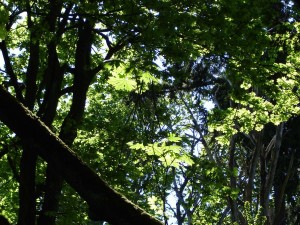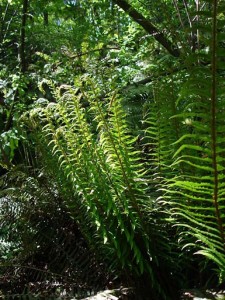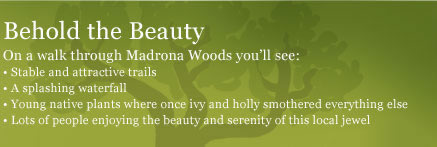
Battle Against Invasives
Madrona Woods and this entire area of Seattle was clear-cut more than 100 years ago. The natural succession of plants which would have followed has been disturbed by the urban environment that has grown up around it. There are few western red cedars, Doublas firs and western hemlocks, which would have been the majority of big trees by this time. Instead, big-leaf maples nearing the end of their natural lives make up most of the canopy. The conifers have not been able to take root and grow because of the mat of ivy on the ground and the superior survivability of invasive English holly and laurel trees.
There are also some copper beech, buckeye, hawthorn, cherry and mountain ash, which are not native but are not terribly invasive. All these invasive and exotic species were probably “planted” in the Woods by birds and neighbors who had them in their yards. The English ivy is the most common invasive plant covering the ground and trees, but dragon arum, herbrobert, English plantain, purslane, buttercup, European bittersweet nightshade, bindweed and clematis are other exotics competing for space here. A major portion of the restoration work involves eliminating exotics and replacing them with suitable native plants.
Native Trees and Plants

The most common tall trees in Madrona Woods are big-leaf maples. Other deciduous trees here are beaked hazelnut, red alder, red elderberry, Pacific dogwood, Oregon ash and black cottonwood. The tallest evergreen trees are the conifers—Douglas-firs, western red cedars and western hemlocks—which have needles and cones. The Pacific madrone is a native evergreen that is not a conifer. Much of the understory in the Woods has beem cleared of ivy, holly and laurel, and you can find many native shrubs that have been uncovered or planted. These include salal, Oregon grape, snowberry, Oregon viburnum, red and evergreen huckleberry, red flowering currant, oceanspray, wood sorrell and Indian plum or osoberry. The Himalayan blackberries that have taken over in places are an invasive species, but native berries include thimbleberry and salmonberry.

Several kinds of ferns grow in the Woods, but the most common is the sword fern. You can also find lady ferns and bracken ferns and licorice ferns growing in the maple trees. A few deer and maidenhair ferns have been planted. Native plants sharing the forest floor with the ferns at different seasons of the year include wood sorrel, horsetail (equisetum), skunk cabbage, trillium, cow parsnip, goatsbeard, bleeding heart, columbine, climbing honeysuckle, clover, fringe cup, inside-out plant, piggy-back plant, vanilla leaf, wild ginger and violet.
Birds
There is lots of bird life in the Madrona Woods, ranging from the bald eagle in the top of the tallest Douglas fir to the tiny Anna’s hummingbird. Both of these are here all year round, as are many others familiar species, like crows, robins, black-capped and chestnut-backed chickadees, house finches, fox sparrows and rose breasted nuthatches. Bird watchers may also see or hear bushtits, Bewicks and winter wrens, band-tailed pigeons, Stellar’s jays, yellow-rumped, orange-crowned and Townsends warblers, golden crowned kinglets, brown creepers, spotted towhees, flickers, pileated, downy and hairy woodpeckers, pine siskins and their cousins the goldinches,varied thrushes (robins’ cousins), and maybe even a red-tailed, Coopers or sharp shinned hawk.

 >Fauna
>Fauna
Periodically, you will see bald eagles diving and cavorting above the forest canopy. Other animals you are likely to see are gray squirrels, which have mostly driven out the native Douglas squirrel. You might see raccoons or opossums, mice and rats, moles and voles and bats. If you’re lucky, you might see a coyote. There have been a few sightings of salamanders, and many hope for the return of tree frogs. If you want to get your hands dirty, there are plenty of bugs and worms to uncover in rotting wood or soil. Spiders are easily spotted in their webs along the trails.

